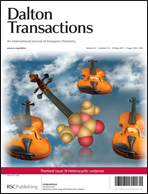Density functional theory calculations have been employed to investigate the scope and selectivity of the hydrodefluorination (HDF) of fluoroarenes, C6F6−nHn (n = 0–5), at catalysts of the type [Ru(NHC)(PR3)2(CO)(H)2]. Based on our previous study (Angew. Chem., Int. Ed., 2011, 50, 2783) two mechanisms featuring the nucleophilic attack of a hydride ligand at a fluoroarene substrate were considered: (i) a concerted process with Ru–H/C–F exchange occurring in one step; and (ii) a stepwise pathway in which the rate-determining transition state involves formation of HF and a Ru-σ-fluoroaryl complex. The nature of the metal coordination environment and, in particular, the NHC ligand was found to play an important role in both promoting the HDF reaction and determining the regioselectivity of this process. Thus for the reaction of C6F5H, the full experimental system (NHC = IMes, R = Ph) promotes HDF through (i) more facile initial PR3/fluoroarene substitution and (ii) the ability of the NHC N-aryl substituents to stabilise the key C–F bond breaking transition state through F⋯HC interactions. This latter effect is maximised along the lower energy stepwise pathway when an ortho-H substituent is present and this accounts for the ortho-selectivity seen in the reaction of C6F5H to give 1,2,3,4-C6F4H2. Computed C–F bond dissociation energies (BDEs) for C6F6−nHn substrates show a general increase with larger n and are most sensitive to the number of ortho-F substituents present. However, HDF is always computed to remain significantly exothermic when a silane such as Me3SiH is included as terminal reductant. Computed barriers to HDF also generally increase with greater n, and for the concerted pathway a good correlation between C–F BDE and barrier height is seen. The two mechanisms were found to have complementary regioselectivities. For the concerted pathway the reaction is directed to sites with two ortho-F substituents, as these have the weakest C–F bonds. In contrast, reaction along the stepwise pathway is directed to sites with only one ortho-F substituent, due to difficulties in accommodating ortho-F substituents in the C–F bond cleavage transition state. Calculations predict that 1,2,3,5-C6F4H2 and 1,2,3,4-C6F4H2 are viable candidates for HDF at [Ru(IMes)(PPh3)2(CO)(H)2] and that this would proceed selectively to give 1,2,4-C6F3H3 and 1,2,3-C6F3H3, respectively.
![Graphical abstract: Computational study of the hydrodefluorination of fluoroarenes at [Ru(NHC)(PR3)2(CO)(H)2]: predicted scope and regioselectivities](/en/Image/Get?imageInfo.ImageType=GA&imageInfo.ImageIdentifier.ManuscriptID=C3DT32962C&imageInfo.ImageIdentifier.Year=2013)

 Please wait while we load your content...
Please wait while we load your content...